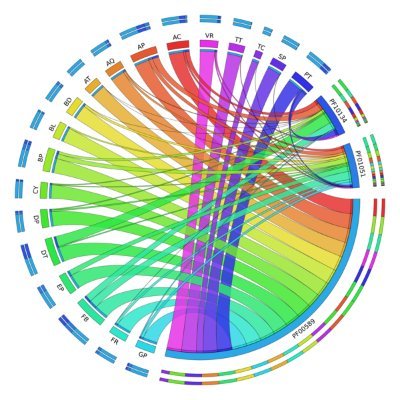
Hasindu Gamaarachchi
@Hasindu2008
Followers
1K
Following
1K
Media
83
Statuses
1K
Lecturer at UNSW Sydney; Visiting Scientist at Garvan Institute of Medical Research - Designing embedded systems for bioinformatics applications.
Sydney, New South Wales
Joined May 2012
Blow5 is the archival format of choice for all internal ONT raw data around here. IMHO slow5 output also makes it easy to look at the raw signal data and play around with it for learning & analysis purposes. I should really write up some visualization tutorials soon.
Benchmark comparing SLOW5 and POD5 for nanopore raw signal data has now been published at @GigaScience
https://t.co/C2ojV7pdV9. Some plots required a log scale - RAM usage and random access time.
1
1
5
Benchmark comparing SLOW5 and POD5 for nanopore raw signal data has now been published at @GigaScience
https://t.co/C2ojV7pdV9. Some plots required a log scale - RAM usage and random access time.
2
3
9
For anyone interested, we uploaded another new HG002 @nanopore R10.4.1 (e8.2.1 enzyme) dataset with raw signals and super-accurate basecalls. Reads lengths: 9.0 kbases median, 17.2 kbases mean See: https://t.co/oU6zmtYS4x
gentechgp.github.io
Open Data from Genomic Technologies Group
0
3
15
f5c v1.6 released. Now it supports a wide range of AMD GPUs. Something me and @bonson_wong worked on during a hackothon organised by CSC and @PawseyCentre
https://t.co/Nr0zX4s019 If you have any @AMD GPUs lying around, help us test the binaries.
github.com
What's Changed updated slow5lib to 1.3 to support ex-zd compressed blow5 fix unnecessary tab being printed in resquiggle tsv output [see #180 ] improvements to error/warning messages f5c now s...
0
3
6
Preprint out for myloasm, our new nanopore / HiFi metagenome assembler! Nanopore's getting accurate, but 1. Can this lead to better metagenome assemblies? 2. How, algorithmically, to leverage them? with co-author Max Marin and supervised by Heng Li @lh3lh3
High-resolution metagenome assembly for modern long reads with myloasm https://t.co/lGIxJcirLX
#biorxiv_bioinfo
1
19
55
Cornetto v0.2.0-beta released https://t.co/Sp2CHp1BmT Cornetto is not only an iterative assembly method for @nanopore, but also features some basic assembly evaluation tools that we implemented. Suggestions and feedback welcome!
github.com
adaptive genome assembly using nanopore sequencing - hasindu2008/cornetto
1
4
18
https://t.co/grP1A0aWtp is potentially a phishing site. Please don't use anything from that website. https://t.co/dSLApEp5gJ
github.com
Not sure how to label this one, but I have come across a website minimap2.com which appears to be AI generated but is serving it's own copy of the Github repository. If you search the address o...
1
27
49
Come join us this November 13th for the Garvan Long-Read Research Symposium! You'll hear about the wonderful things you can do with @nanopore and @PacBio long reads from a great line-up of speakers. FREE to attend. Register below https://t.co/vMc0x3mwmz
eventbrite.com.au
Join us at the Garvan Long-Read Research Symposium 2025 for a deep dive into groundbreaking discoveries in medical research!
0
6
8
Dr Hasindu Gamaarachchi @Hasindu2008 @unsw is a finalist in the @Macquarie_Uni Eureka Prize for Outstanding Early Career Researcher. Learn more: https://t.co/UUi3YHdT6V
#EurekaPrizes
0
1
7
Longdust, a new tool to identify highly repetitive STRs, VNTRs, satellite DNA and other low-complexity regions (LCRs). Similar to SDUST but for long regions. https://t.co/xUFgpmatJ5
github.com
Identify long STRs, VNTRs, satellite DNA and other low-complexity regions in a genome - lh3/longdust
2
70
201
Minimod preprint by @sunethsam is out https://t.co/EXYD19OriZ -similar accuracy to modkit & pb-CpG-tools. -standard open-source licenses (NOT vendor-specific) -Simple but faster, on a laptop ~4X for DNA and ~55X for RNA. Code: https://t.co/J1OJ9cImqr
0
4
32
If you are at #ISMB2025: #BOSC2025 track around 2:30pm ish after @sunethsam's talk , @bonson_wong will present on @nanopore basecalling on @AMD GPUs using slorado [ https://t.co/n2PyhrYMC8]
github.com
A simplified version of Dorado built on top of S/BLOW5 format. - BonsonW/slorado
2
5
17
If you are at #ISMB2025: Go to the #BOSC2025 track around 2:30pm ish where @sunethsam will present on real-time @nanopore realtime modification frequency calculation using realfreq [ https://t.co/GIOfdwv5ff] and standalone frequency calculation using minimod.
academic.oup.com
AbstractSummary. Nanopore sequencers allow sequencing data to be accessed in real-time. This allows live analysis to be performed, while the sequencing is
0
5
20
New squigualiser-v0.6.4 is out with a new subtool to plot signals (plot_signal) 🚀Just download and execute our standalone binaries (linux/macos). https://t.co/G4Ht6HfxfD Below is @nanopore r10 and r9 dna signal-to-reference comparison (check Advanced Examples in repo).
0
4
14
We've been developing a small standalone tool for viewing & calculating frequency from modification tags in BAM files. This call is for brave users to test. https://t.co/J1OJ9cImqr written by @sunethsam in C, based on mod tag parsing we did for realfreq
2
11
42
blue-crab v0.4.0 released - yet another end_reason added to support pod5 updates. To convert POD5<=>S/BLOW5 simply: pip install blue-crab pod5->blow5 blue-crab p2s example.pod5 -o example.blow5 blow5->pod5 blue-crab s2p example.blow5 -o example.pod5 https://t.co/5D0aivnpvQ
github.com
What's Changed New paused end reason and test updates Full Changelog: v0.3.0...v0.4.0
0
3
9
This shows the technicality (previously known) that using mmap for reading large files with predictable access pattern which the programmer can well know in advance than what the operating system can guess -> can lead to unpredicable performance outcomes.
0
0
2
Key observations - sequential access: BLOW5 ~7X faster on academic HPC we tested. Similar performance on desktops with single SSD drives. - random access: BLOW5 is always significantly fast (sometimes 100X) - size: similar if same compression - Dependencies: BLOW5 ~3, POD5 >50
1
0
5
For many of those who were asking on BLOW5 vs POD5 for nanopore signal data, here is a finally detailed benchmark we did: https://t.co/ZspXSlrW9e Summary: performance of BLOW5 is >= POD5 (from ~= to 100X, see below), with benefit of having ~3 dependencies instead of >50.
1
19
55















